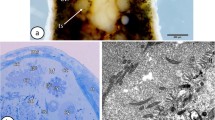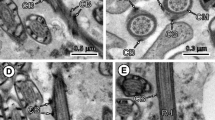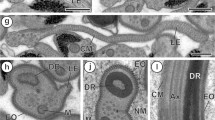Summary
The testes of Phialidium were studied in the living and in histological and electron microscopic preparations. The testes are well differentiated organs in which germ cells and supporting epithelium are arranged in a well defined pattern and function in close correlation.
The germ cells are arranged in layers. Typically there are five or six of these, each representing one generation which develops synchronously. The youngest and largest spermatogonia are situated at the mesogloeal lamella, the most mature spermatids under the surface of the testis. A few cells of spermatogonial appearance are found within the gastrodermis.
The supporting cells form the surface of the testis. They are flagellated and pigmented. They send processes at regular intervals through the mass of germ cells to the mesogloeal lamella.
Gametes are released approximately every 12 hours. The release is normally stimulated by the onset of darkness or of light. In spermiation the surface parts of the epithelial cells become dissociated for minutes, and reassociate immediately after the mature spermatozoa have escaped through the resulting gaps. Immediately below the testicular surface the epithelium displays modified areas of adjacent cell surfaces which may be part of the mechanism of dissociation. Septate desmosomes were found only very rarely.
Similar content being viewed by others
References
Bouillon, J.: Etude monographique du genre Limnocnida (Limnomeduse). Ann. Soc. roy. zool. Belg. 87, 254–471 (1957).
Brien, P., et M. Reniers-Decoen: Etude d'Hydra viridis (Linnaeus) (La blastogénèse, la spermatogénèse, l'ovogénèse). Ann. Soc. roy. zool. Belg. 81, 33–110 (1950).
—, et M. Reniers-Decoen: La gamétogénèse et l'intersexualité chez Hydra attenuata (Pallas). Ann. Soc. roy. zool. Belg. 82, 285–327 (1951).
Hertwig, O., u. R. Hertwig: Der Organismus der Medusen und seine Stellung zur Keimblättertheorie. Jena 1878.
Hyman, L. H.: The invertebrates, vol. I. New York and London 1940.
Kramp, P. L.: Notes on some eastern pacific species of Phialidium (Leptomedusae). Pacific Sci. 16, 1–14 (1962).
Leblond, C. P.: The time dimension in histology. Amer. J. Anat. 116, 1–27 (1965).
Luft, J.: Improvements in epoxy resin embedding methods. J. biophys. biochem. Cytol. 9, 409–414 (1961).
Reynolds, E. S.: The use of lead citrate at high pH as an electron-opaque stain in electron microscopy. J. Cell Bio. 17, 208 (1963).
Roosen-Runge, E. C.: Cyclic spermatogenesis in a hydromedusa (Phialidium L.) as compared with the rat. Anat. Rec. 136, 267 (1960) (Abstract).
—: On the biology of sexual reproduction of hydromedusae, genus Phialidium Leuckhart. Pacific Sci. 16, 15–26 (1962a).
—: The process of spermatogenesis in mammals. Biol. Rev. 37, 343–377 (1962b).
Wood, R. L.: Intercellular attachment in the epithelium of Hydra as revealed by electron microscopy. J. biophys. biochem. Cytol. 6, 343–352 (1959).
Author information
Authors and Affiliations
Additional information
This study was supported by a grant from the National Science Foundation, G-23738.
Thanks are due to Mr. Robert E. Waterman for his invaluable assistance in taking the motion pictures.
Rights and permissions
About this article
Cite this article
Roosen-Runge, E.C., Szollosi, D. On biology and structure of the testis of Phialidium Leuckhart (Leptomedusae). Zeitschrift für Zellforschung 68, 597–610 (1965). https://doi.org/10.1007/BF00340088
Received:
Issue Date:
DOI: https://doi.org/10.1007/BF00340088




